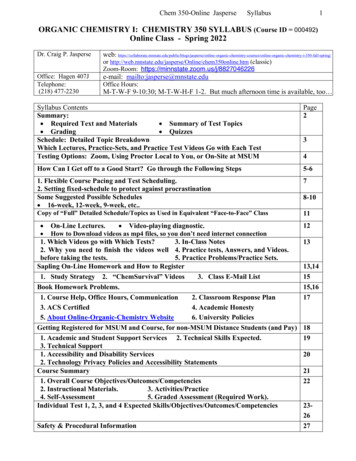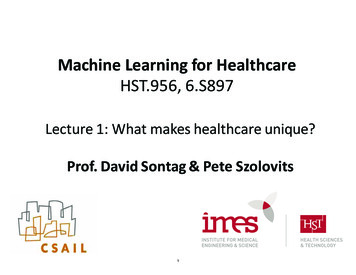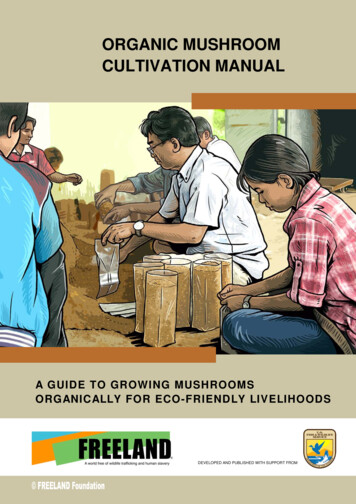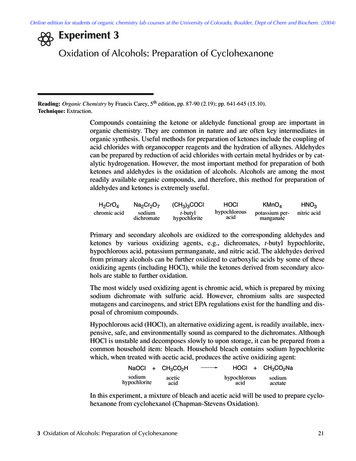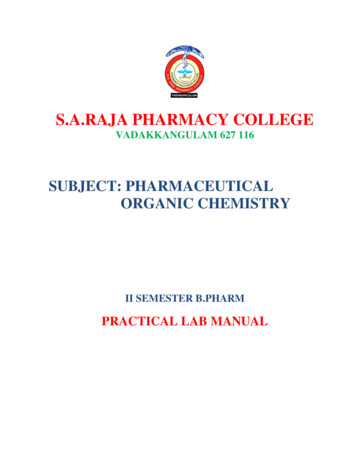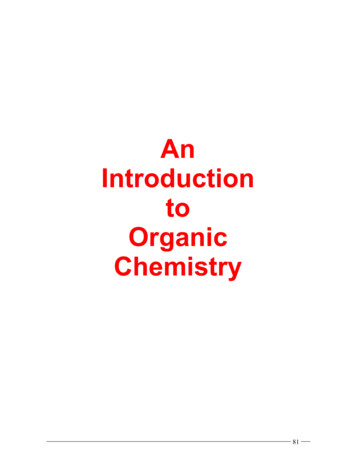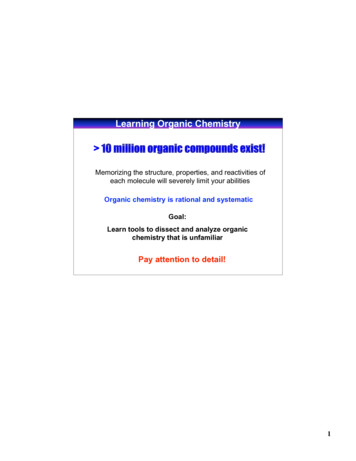
Transcription
Learning Organic ChemistryMemorizing the structure, properties, and reactivities ofeach molecule will severely limit your abilitiesOrganic chemistry is rational and systematicGoal:Learn tools to dissect and analyze organicchemistry that is unfamiliarPay attention to detail!1
Study Tips1.Read the suggested readings before coming to class and record the mainideas.2.After each lecture, summarize the major ideas and concepts in your noteswithin 24 hours of class.3.Annotate these summaries from your study of the textbook4.Work the problems independently5.Master the material from each lecture before going to the next one.6.Spend a few minutes each day on review to prevent becoming overwhelmedon the night before an exam.You cannotfor an OrganicSyllabus Organic chemistryStructure and reactivityResonanceAcidity and basicity of organic compoundsAlkanesStereochemistryOverview of organic reactionsAlkenesAlkynesAlkyl halidesBenzene and aromatic compoundsAlcohols and phenolsCarbonyl compoundsSynthesis using the chemistry of 5.122
Background Review1.2.3.4.5.Atomic StructureAtomic OrbitalsElectron ConfigurationIonic/Covalent BondingLewis Structures6. Formal Charges7. Valence Bond Theory8. VSEPR Theory9. Hybridization10. MO TheoryGo the the 5.12 Web Page and work through:q Background Handout (PowerPoint and .pdf)q Background Knowledge QuizSuggested Readings (McMurry): 1.1-1.12, 2.1-2.3Suggested Problems (McMurry): 1.1-1.16, 1.21-1.47, 2.1-2.9, 2.29-2.35Lecture 1: Outlineq Organic Chemistryq Relationship of Structure, Energy, and Reactivityq Structureq Atomsq Bondingo How/Why Atoms Bond Togethero Bonding Patternsq Representing molecules (putting the atoms together)o Lewis and Kekulé Structureso Line-angle Formulao 3-Do Orbital Drawingsq Functional Groupsq ResonanceSuggested Readings (McMurry): 2.4-2.12Suggested Problems (McMurry):2.36-2.41, 2.43-2.51, 2.53-2.57, 2.593
Organic ChemistryWhat: The study of carbon-containing compoundsWhy:Pervasive in natureChemical foundation of biologyImprove standard of living (medicines, plastics, pesticides . . .)How:Examine structure and analyze how it governs reactivityWhat: Carbon-Containing CompoundsMiddle of second rowLiBeBCNOFCan neither accept or give up electrons easilyShare e- with other carbon atoms - incredible structure diversity!HormoneAmino acidDNA baseCH3 O2NNNO2CH3AdenineTNTOCH3OHCH3HNH3CCapsaicin (peppers)O4
Subtleties in StructureCH3 OHCH3 OHH3CHOOestradiolH3CtestosteroneOHOOOH3COOHN CH3HOOHN CH3H3CHOcodeineHOmorphineN CH3OheroinWhy: Life is Based on Organic 0%70%60%50%40%30%20%10%0%UniverseCrustal RockSeaHumanCourtesy of Jeffrey S. Moore, Department of Chemistry, University of Illinois at Urbana-Champaign.Used with permission. Adapted by Kimberly Berkowski.5
How: Structure and ReactivityStructure - what atoms are present & how they are bonded togetherReactivity - potential of structure to undergo chemical changeIf likely - reactive (unstable)If unlikely - unreactive (stable)StructurePotential EnergyReactivityPotential Energy:- function of position or configuration of components- if low, compound more stable, change less likely- if high, compound less stable, change more likelyCourtesy of Jeffrey S. Moore, Department of Chemistry, University of Illinois at Urbana-Champaign.Used with permission. Adapted by Kimberly Berkowski.StructureFoundation of organic chemistry1. What atoms (besides carbon) are important?2. How are these atoms bonded together?Courtesy of Jeffrey S. Moore, Department of Chemistry, University of Illinois at Urbana-Champaign.Used with permission. Adapted by Kimberly Berkowski.6
Structure - Atoms of Organic MoleculesFood we eat, fragrances we smell, colors we see, clothes we roleumdrynonvascularplant tissuedry vascularplant tissuedry humanmuscle tissueBody 23% C(H20 65% mass)Typical drug contains 20-80 atoms (C, H, N, O, F, S, P, Cl, Br, I)Courtesy of Jeffrey S. Moore, Department of Chemistry, University of Illinois at Urbana-Champaign.Used with permission. Adapted by Kimberly Berkowski.Main Atoms in Organic ChemistryHHeLi BeBC N O F NeNa MgAlSiK Ca Sc TiRb SrYVP S Cl ArCr Mn Fe Co Ni Cu Zn Ga Ge As Se Br KrZr Nb Mo Tc Ru Rh Pd Ag Cd InSn Sb TeIXeElectron configuration:number and arrangement of electrons about an atomCourtesy of Jeffrey S. Moore, Department of Chemistry, University of Illinois at Urbana-Champaign.Used with permission. Adapted by Kimberly Berkowski.7
Electron Configuration of Main AtomsGround StateElement Configuration1s2s2p3s3p1H1sHe1s2Li1s 2sBe1s22s222121B1s 2s 2pC1s22s22p2N1s 2s 2pO1s22s22p4F1s 2s 2p22322225226226226222622262Ne1s 2s 2p6Na1s 2s 2p 3s1Mg1s 2s 2p 3s2Al1s 2s 2p 3s 3p1Si1s 2s 2p 3s 3p2P1s 2s 2p 3s 3p3S1s22s22p63s23p4Cl1s 2s 2p 3s 3pAr1s22s22p63s23p622625Courtesy of Jeffrey S. Moore, Department of Chemistry, University of Illinois at Urbana-Champaign.Used with permission. Adapted by Kimberly Berkowski.Electron Configuration and Valence ElectronsElectron redistribution (change in configuration)is the origin of chemical changeWHY? Attain lower ENERGY(achieved when outer shell is filled - 8 electrons)Process of chemical bonding:adding or taking away outer shell electrons to gain a closed shell configurationHow do atoms maintain 8 electrons as well as participate in chemical bonding?8
Bonding Possibilities of Main Organic AtomsEach atom has a limited number of possibilities to satisfy octet:1. Nonbonding (electron pair localized on one atom)2. Bonding (electron pair shared between two atoms)a. Single bond (1 shared pair)b. Double bond (2 shared pairs)c.Triple bond (3 shared pairs)HHHH C C O HH C N HH C C NH OH Hmethyl amineHacetonitrileacetic acid(H is exception to octet rule - has 1 electron)Electron Pair Domain - region of high valence shell electron density(bonding or nonbonding)Bonding Patterns: Formal Charge 0# Electron Pair Domains43210HHCCCNNNOOOFFCCNCourtesy of Jeffrey S. Moore, Department of Chemistry, University of Illinois at Urbana-Champaign.Used with permission. Adapted by Kimberly Berkowski.9
Bonding Patterns: Formal Charge 1# Electron Domains4HOF21 0H CN3CNNOOFF CNNOCourtesy of Jeffrey S. Moore, Department of Chemistry, University of Illinois at Urbana-Champaign.Used with permission. Adapted by Kimberly Berkowski.Bonding Patterns: Formal Charge -1# Electron Domains4HCNOF32--0HCC-NN-O-1CFCourtesy of Jeffrey S. Moore, Department of Chemistry, University of Illinois at Urbana-Champaign.Used with permission. Adapted by Kimberly Berkowski.10
BoronBElectron configurationHHSpecial reactivityBHHHHHNeutral, but electron deficientcan tolerate an incompleteoctet better than any otheratom in the second rowBOctet, but chargedEN 2, least suited of allsecond row elements to carrya negative chargeCourtesy of Jeffrey S. Moore, Department of Chemistry, University of Illinois at Urbana-Champaign.Used with permission. Adapted by Kimberly Berkowski.Organic Structures: Summary (so far) Organic Chemistry Relationship of Structure, Energy, and Reactivityq Structure Atoms Bonding How/Why Atoms Bond Together Bonding Patternsq Representing molecules Lewis and Kekule Structureso Line-angle Formulao 3-Do Orbital DrawingsEthanolH HH C C O HH HLewis StructureH HH C C O HH HKekulé Structureq Functional Groupsq Resonance11
Representing Molecules: Line-Angle FormulaH H OH N C C OHH C HHH CHIHHCCCCCCOIodomethaneHHHHCH OCCHHTyrosineH HHHHHC OHCC HH CCHCH CCHC HCCHHCC H HCHH HEstradiolOH2NCH3 OHOHLine-Angle FormulaOHHORules of Drawing Line-Angle Formulas Bonds are represented by linesAssume carbon atoms at the ends of lines and where they meetAssume enough C-H bonds to give each carbon atom four bonds (octet)Carbon and hydrogen atoms are only drawn at termini for aestheticsDraw heteroatoms and attached hydrogen atoms (N, O, P, Cl, Br, F, I, etc.)(any atom that is not carbon)HHHHOCCH HH3CHOHHOCCH3Incorrect!(Why?)OHOHHCH CH CHHCCHC HC HHHCH3ODon’t forget aboutthe impliedhydrogen atoms!Always show all lone pairs!(helps with electron bookkeeping)12
Representing Molecules: 3-DLewis/Kekulé and Line-Angle structures don’t tell the whole story!Molecules are not flat - use dashes and wedges to show 3-D imageGoverned by VSEPRHHH C HHH HH C C HH HHC HHHHHCHHCHLine - in plane of paperDash - going into the paperWedge - coming out of the paperH3CHH3CHCH3HCH3HSame atoms, different spatial arrangementRepresenting Molecules: Orbital Drawings IAtomic Orbitalsnode 13
Representing Molecules: Orbital Drawings IIsp3109.5osp3Hybrid Orbitalssp3sp3sp3 electron density distributedto the corners of a tetrahedron180oX120osp2 electron density distributed to thecorners of a triangle (trigonal planar)sp electron density distributed linearlyRepresenting Molecules: Orbital Drawings IIIEthyleneHAcetyleneHC CHH C C HHpi orbitalnetwork14
Functional GroupsThe atoms of organic molecules exist in common combinationsEach combination:ÿ unique chemical properties and reactivityÿ behaves similarly in every organic molecule10 million organic compounds exist!Predict how any one of those compounds reacts by analyzing its“functional groups”groups”Functional Group - group of atomswith characteristic chemical behaviorno matter what molecule it’s inChemistry of every organic molecule, regardless of size or complexity,governed by functional groupsFunctional Groups to LearnNitrogen-ContainingHydrocarbonsalkaneC CalkeneC CalkyneC COxygen-ContainingalcoholamineC NnitrileC C NthiolnitroOC NOsulfoxidesulfideC C OHOHphenoldieneetherSulfur-ContainingimineNC C CC O COHalogen-Containingalkyl halideC C Xketonecarboxylicacid halideOC S CO2 C S COthioesterOC C S COC C XOOC C O C CaldehydeOC C HCarboxylicacid anhydridecarboxylic acidOC C OHesterOC C O CamideOC C NXaryl halideOC C CCarboxylic AcidDerivativesC C SHsulfoneareneepoxideC S C15
On to Resonance . . . Organic Chemistry Relationship of Structure, Energy, and Reactivityq Structure Atoms Bonding How/Why Atoms Bond Together Bonding Patterns Representing molecules Lewis and Kekule Structures Line-angle Formula 3-D Orbital Drawings Functional Groups ResonanceResonanceIF YOU DO NOT UNDERSTANDRESONANCE, YOU WILL NOTPASS 5.12!Resonance is like riding a bike.Once you learn, you neverforget . . .16
When one Lewis structure just isn’t enough Lewis structure for CH3NO2 24 valence e-Resonance contributorResonance contributorHHOHOH C NH C NHOHH C NHOO d-Resonance HybridO d-Electrons are DELOCALIZED A molecule can’t always be accurately represented by one Lewis structureThese molecules are weighted average, or hybrids, of two or more Lewis structures(electrons do not move to either one of the oxygen atoms or the other)A Resonance MetaphorFigure removed due to copyright reasons.17
Why is Resonance So Very Important? 95% of the reactions in 5.12 occur because of the attraction of one moleculecontaining a region of high electron density to a second molecule containinga region of low electron density To predict how and when two molecules will react, need to be able topredict the regions of low and high electron densityONOResonance hybrid(lone pairs not depicted inresonance hybrids)ONOdOdNOONOd-Tracking Changes in e- ConfigurationONOONOONONeed a way to keep track of the changes in electronconfiguration between resonance contributorsCourtesy of Jeffrey S. Moore, Department of Chemistry, University of Illinois at Urbana-Champaign.Used with permission. Adapted by Kimberly Berkowski.18
Study Tips 1. Read the suggested readings before coming to class and record the main ideas. 2. After each lecture, summarize the major ideas and concepts in your notes within 24 hours of class. 3. Annotate these summaries from your study of the textbook 4. Work the problems independently 5. Master the


